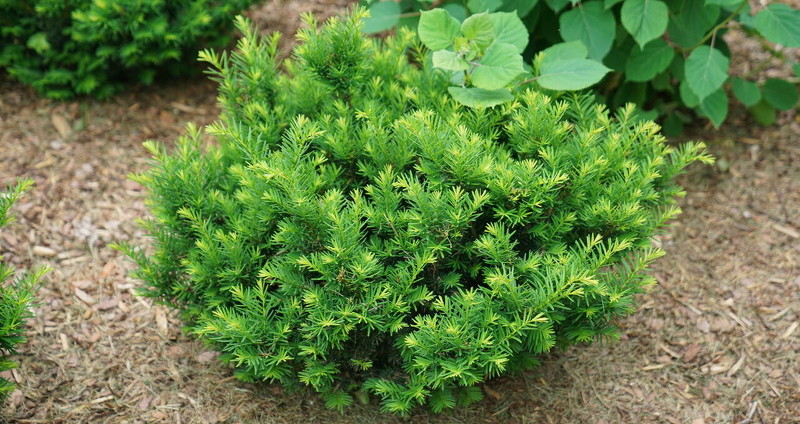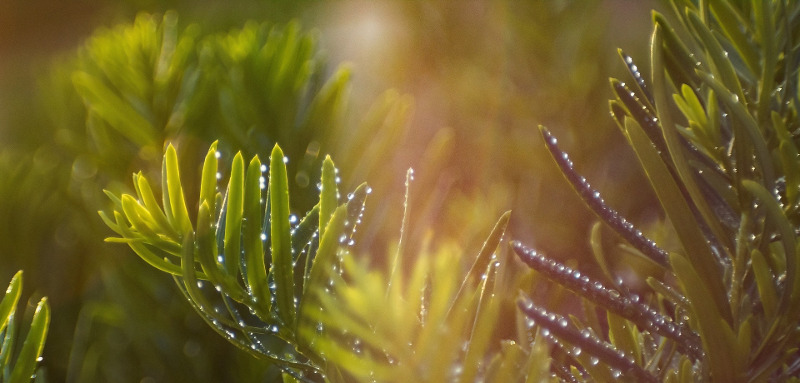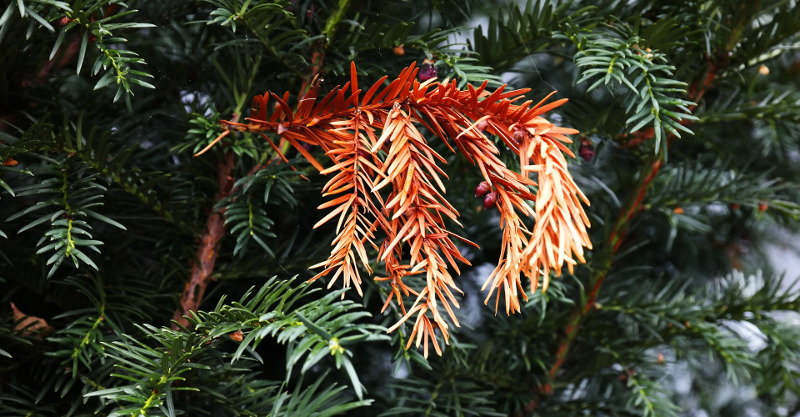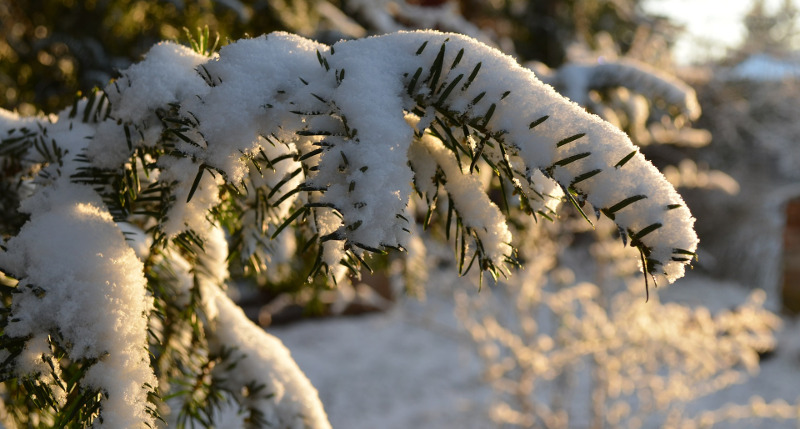Yews (taxus) are a species of evergreen shrub or tree in the family Taxaceae. Also known as common yew, English Yew, or European Yew, it is primarily grown as an ornamental tree. It has qualities that make it commonly associated with the Christmas holiday. Yew stays evergreen and features soft-looking needles and attractive (yet poisonous) berries. Typically colored blue/green or chartreuse/gold, the yew looks great in a container or as a ground cover or privacy screen. Known for its spring berries and winter interest, this fragrant bush attracts birds yet is deer resistant.
Yew is native to several areas including Africa, Asia, and Europe. This plant is tough–it’s drought tolerant when established and hardy through USDA zones 2 to 10. Yews can tolerate most sunlight conditions, but require well-draining soil. Yew has a wide range of uses including borders, topiaries, and hedges. Its mature size, depending on the cultivar, can be 5 to 20 feet tall, giving it the nickname “yew tree”. Yews can be toxic to humans and animals.

Planting Yew Bushes
Before planting your yew, select a location with adequate sunlight and drainage. For best growth results, provide at least 4 hours of sunlight daily, as too little sun can cause growth to thin. Plant it in a location that will be protected from strong winds. If your soil has poor drainage, you can blend in a soil amendment like perlite or compost. Yews grow best in nutrient-rich, loamy soil with a pH close to neutral and will tolerate a pH range between 5.5 and 7.5.
Dig a planting hole that is two times the width of the yew root ball and as deep as the original container. Loosen the roots and place the yew in the planting hole so the top of the root ball rests even with the surrounding soil. Fill the hole with soil and pat down gently. Water thoroughly so the roots are very moist. Weekly deep watering is best until the plant is established.
Watering Yew Bushes
Yews prefer well-drained soil. Upon planting, the yew should be watered thoroughly. Water twice a week or enough to maintain evenly moist soil until your yew is established. Be mindful of constantly soggy or wet soils, which can harm Yew plants. This plant is susceptible to fungal infections and root rot if its roots sit in water for too long. Yew should be well watered but should never sit in standing water.
Mature Yews require minimal watering. Yews tolerate brief periods of drought once established, about 1-2 years from planting. During drought conditions, weekly watering is recommended. Adding a layer of mulch around the base of the plant can help to retain moisture in the soil; however, keep the mulch about one foot away from the trunk.

Fertilizing Yew Bushes
A Yew is an evergreen plant. Like most evergreens, yews are not very heavy feeders when planted in rich soil. They will benefit from fertilizing, particularly during their establishment years. Wait until your yew is established before fertilizing it for the first time. This will take about a year or two after planting. Err on the side of too little plant food over too much to avoid fertilizer burn.
Younger Yew plants (under 15 years) can be fed each spring. More mature trees can benefit from feeding every other year. Apply a nitrogen-rich, 20-15-15 granular or liquid commercial fertilizer around the drip line of the yew. Make sure to always keep the fertilizer about a foot away from the trunk. Alternatively, add a one-inch-thick layer of compost around the root zone.
Pruning Yew Bushes
Yews love to be pruned and can be shaped to your liking. The best time to prune this plant is mid-summer or early spring. Wait until new growth emerges before you start making cuts. Yews can grow quite large, in excess of 25 feet at maturity, and are often considered to be small trees. If left without annual pruning, your Yew plant can easily grow too tall for your landscaping needs.
Yews can sprout from old wood, so they respond well to hard pruning as long as they are healthy. Prune at branch joints where new growth will emerge. If the yew has been sheared over many years, heavy pruning may remove all the remaining foliage, leaving you with bare branches. In this case, you may want to let the yew grow into a more natural shape before you make any severe cuts. Remove damaged or dead branches from your yew plant as needed throughout the growing season.

Caring For Yew Bushes in Pots
Yews look amazing planted in pots perched on a doorstep or entryway. For this plant, use a porous container like a terracotta pot to increase air exchange. Be sure that the pot has drainage holes, as Yews do not like wet roots. Use a nutrient-rich potting soil with added perlite for the best drainage. Your yew may dry out faster in pots, so be aware of its moisture needs. Water yew plants regularly throughout the growing season. Yews grow slowly in containers, so it’s a good option if you want the plant to last for a few years. After a few years being planted in a pot, your yew will benefit from being transferred into the ground.
More sensitive to temperature fluctuations than if it were planted in the ground, a potted Yew can easily die from drastic temperature changes. Once the weather turns colder, it is best to keep your potted Yew in partial shade where it won’t be warmed by the sun only to be shocked by plunging night temperatures. Find a sheltered spot for the container, with protection from snowstorms and heavy winter rains.
Winter Care for Yew Bushes
Despite being winter hardy and drought tolerant, Yew trees and shrubs can be harmed by winter weather. Winter injury is more likely to occur after extreme temperature fluctuations rather than prolonged cold weather. Hot day temperatures followed by frigid nights can stress the plant. Bright sunshine and inadequate water reserves in the yew’s root system can also cause stress. To help prevent winter burn, soak the top 2 feet of soil before it freezes in fall. This allows the plant to store up needed moisture for the winter months. In addition, adding mulch around the base of the plant can help retain much-needed moisture in the soil.
For areas prone to heavy snow, shake snow off the branches to prevent branch and needle damage. Removing snow can prevent browning needles and branch breakage. An annual pruning in late summer can also help reduce storm breakage.

Common Yew Shrubs Care Questions
Do Yews Turn Brown In The Winter?
Yew should not turn brown in the winter. When they do, it is often indicative of too much sunlight and not enough water. It can, however, also be caused by quickly changing winter temperatures.
Do Yews Like Sun Or Shade?
Some varieties of yew, Stonehenge, Stonehenge Dark Druid, and Stonehenge Skinny can do well in full shade to full sun. Most others will prefer partial shade to full sun conditions.
What Is The Growth Rate For Yews?
Yews have a fairly slow growth rate and most often gain less than 1 foot per year.
Are Yews Drought Tolerant?
Yews are generally considered to be drought-tolerant, watering during very dry periods is necessary to avoid problems. Providing a well-drained home is best because they also do not like to be wet.
Have a question about Yew Shrubs? Fill out the form below and we will try and get back to your question as soon as possible. We may even feature your question on this article to help other gardeners!
 |
Author Chris Link - Published 3-17-2023 |
